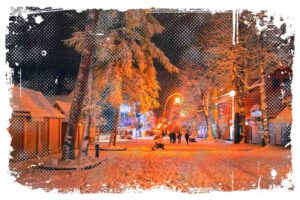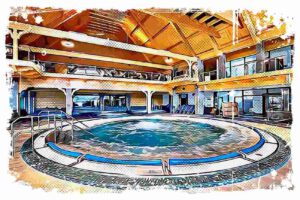In my experience, when visiting Zakopane and the Podhale region, you should definitely try the local trout, lamb and mutton dishes prepared in various ways. Many restaurants offer trout fried in butter and paired with oscypek cheese. You should also try lamb, roast mutton, highland pork knuckle and, of course, the warming sour soup, which typically contains mutton – perfect after skiing or hiking in the mountains.

During the summer and fall months in Zakopane, I recommend trying the mushroom soup and butter fried mushrooms. Placek Zbójnicki (large potato pancakes with goulash) is also very popular. If you are visiting Zakopane for the first time, don’t miss the opportunity to taste the fantastic flavors of the Zakopane cuisine, which is based on natural ingredients.
Below I’ve listed various cheeses and some more traditional dishes that are no longer easily found in the inns and restaurants of central Zakopane.
You may also like: Discovering the Best Sites of Krupówki: Zakopane’s Old Town
↳ Make sure to check out my guide to ALL attractions in Zakopane, so you don't overlook anything interesting: 66 Best Attractions in Zakopane 2023 – What to Do – Interesting Places
Highland cuisine may not be particularly sophisticated, but it has a unique charm. Remember that life in the Tatra Mountains was difficult due to the harsh climate and infertile soil, which produced mainly grain and potatoes. The physically demanding daily work required a high caloric intake. Therefore, the traditional highlanders’ cuisine was low in calories and based on a few ingredients such as potatoes, flour, cabbage and animal fat. Meat was reserved for holidays and special family celebrations, while sheep’s cheese, despite its popularity, was not consumed daily.
Bread was rarely eaten in Zakopane homes, and potato-based pancakes and pasta were typically eaten instead. Dairy products were consumed in the form of rye milk, buttermilk, or sour milk.
Let’s now delve into the various cheeses, soups, pancakes, noodles, and more that are characteristic of Zakopane cuisine.
Oscypek Cheese

I can tell you that Oscypek is a unique cheese, made exclusively in shepherd’s huts during the summer grazing period of the sheep, and has the Protected Designation of Origin. This means that its production takes place only in a specific area and the name „Oscypek” is reserved for cheeses made according to traditional methods. If you buy oscypek without the mark, it’s not the authentic, traditional oscypek. It’s important to remember this because many tourists often buy something called „highlander’s cheese”, which is similar to oscypek, but is not the same.
Oscypek is a hard, smoked sheep’s cheese (at least 60% sheep’s milk), sometimes with cow’s milk added (up to 40%). It’s made from the mass left after curdling the milk and making bunz. The cheese should be alternately boiled in hot water and squeezed to obtain an elastic consistency. It is then formed into spirals and imprinted with patterns using special molds called „oscypiorek”. Oscypek is soaked in brine and smoked for several days. It takes about 7 liters of sheep’s milk to make one cheese, which weighs 60-80 dag.
There is also a Oscypek Museum, that you can visit and make your own cheese. Please read more: Oscypek Museum in Zakopane: A Must-Visit Place for Cheese Lovers
Other Types of Zakopane Cheeses
- Brusek – a smaller version of Oscypek (up to 50 dag), cylindrical in shape.
- Redykołka – a small sheep’s milk cheese pressed in wooden forms shaped like animals, hearts or steamers. Redykołki can be smoked or unsmoked (white). The name comes from an old tradition when shepherds returning from the pastures (redyk) in the fall gave them as gifts, especially to children.
- Bundz – white sheep’s cheese, similar to cottage cheese with a slightly sweet taste. As it matures, the cheese becomes slightly sour and characteristic holes appear in the middle.
- Bryndza – A cheese made from salted and ground ripe bunz. It has a salty taste, sometimes slightly sour or piquant. Bryndza was the first to be recognized as a regional product and to receive an EU certificate.
- Golka – Traditional smoked cheese with delicate taste. Often confused with oscypek, gołka is less salty and less intense and is made from cow’s milk.
- Korboce – A staple at family events, especially weddings. Made from cow’s milk, it resembles pasta strands. Korboce has a mild taste, not as salty as sheep’s cheese, and can be smoked or unsmoked.
Traditional Zakopane Dishes

- Kwaśnica (Sour Soup) – A popular soup in the Tatra Mountains, listed as a traditional product. It has a distinct sour-salty taste, slightly spicy, warming and filling. It’s prepared with sauerkraut and meat (mutton or pork, sometimes with smoked ribs) and eaten with potatoes or bread.
- Bryjka – This is a regional dish of Zakopane cuisine. It is rarely served in inns. It was an everyday dish, not very exquisite or interesting in taste. It’s prepared by boiling flour in salted water, and when the lump thickens, it’s put into a bowl, rubbed and covered with fat (lard, bacon or butter). Sometimes buttermilk or whey was added.
- Garlic Soup – A tasty, warming traditional soup from Zakopane. Boiled with potatoes, garlic, onion and mint, it is seasoned with salt and sometimes melted pork fat.
Traditional Zakopane Pancakes and Noodles

- Highlander Pie (pl: Placek po Zbójnicku)- A popular dish in every inn, it is similar to the Hungarian pie and shows the influence of Hungarian tradition on Zakopane cuisine. It’s made of potatoes, fried into a large, thin pancake and served with meat stew.
- Moskole – Traditional pancakes baked on a baking sheet, originating from Russian cuisine and introduced to the Tatra Mountains during World War I. Made from boiled and mashed potatoes, flour, water and salt, the dough is well kneaded and formed into small cakes before being baked on a baking sheet. Properly prepared, moskole have a lightly toasted, crispy crust and a tender center. They are best served with garlic butter and a pinch of salt.
- Hałuski – Less popular than moskole, hałuski are dumplings made from grated potatoes, salt and flour. Raw potatoes are grated and left to release water (starch). The potato mass is then mashed, mixed with flour and starch to form a thick paste, and small portions are thrown into boiling water. Hałuski is served with cheese or topped with fat.
- Potato Pancakes (pl: Placki Ziemniaczane) – Boil potatoes until soft, then gradually add flour, making sure the mixture doesn’t get too thick. Cook over a low heat for a while, then pound the mixture with a pestle, form into noodles and place in a bowl. Pour melted smoked pork fat over the pasta.
Traditional Zakopane Meat Dishes
Meat dishes were rare in traditional highland cuisine, served only during holidays or family celebrations such as weddings. The most common meats were mutton and lamb. While in Zakopane, you should try the traditional mutton or lamb roast.
Highland style knuckle of pork is closely associated with the cuisine of the Tatra region, and meat lovers will certainly enjoy it. It’s filling, rich and not at all diet friendly, but it’s hard to resist while in the Tatra Mountains.
As a lighter alternative, we recommend highlander trout. It is prepared by sprinkling it with flour, frying it and then baking it with a cream sauce.
Traditional Zakopane Sweets
In the past, desserts and sweet pastries were baked only for holidays. Today’s highland sweets may not be traditional highland sweets, but they’re still worth trying. We recommend potato and yeast cake (called „hrube baby”), „kremarz” (a honey-based cake topped with cream), as well as „kołacze”, „makowce”, and apple strudel.
Żętyca Bewarage
Finally, I must mention the traditional highland drink, Żętyca or zyntyca. It’s made from sheep’s milk during the cheese-making process. Fresh Żętyca has a sweet taste, while the one aged for several days is more sour. Highlanders consider it a curative drink that increases strength and endurance. Żętyca is on the list of traditional products and can be tasted only in shepherds’ huts during the grazing season.
References
- https://www.goral.pl/zakopane-jedzenie-regionalne/
- https://zakopane.naszemiasto.pl/podhale-jakie-regionalne-potrawy-zjesc-podczas-pobytu-w/ar/c7-7888751




